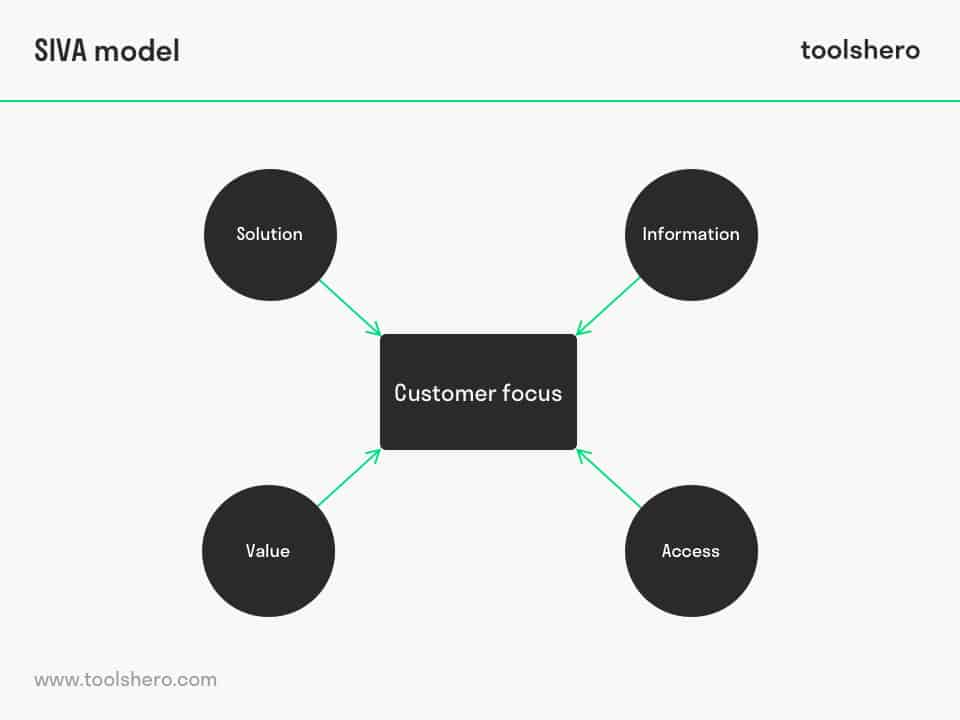SIVA model

SIVA model: this article provides a practical explanation of the SIVA model. After reading, you will understand the basics of this powerful marketing tool.
What is the SIVA model?
Customers more or less justify the existence of any company. Customers may be business-to-business customers or consumers who purchase products and/or services.
By thinking in a customer-oriented manner and putting the customer first, companies are better able to respond to their needs. The SIVA model is based on such a customer-oriented approach.
Thinking from the point of view of the customer is crucial to any customer-oriented business. The SIVA model is a practical model, which stands for Solution, Information, Value, and Access.
In many cases, the SIVA model is mentioned in the same breath as the marketing mix, also known as McCarthy’s 4 P’s. The SIVA model and 4 P’s marketing mix are both models that were introduced to better analyse target groups.
The traditional marketing mix is based on product-oriented thinking, which revolves around Product, Price, Promotion, and Place. In a changing market and environment, where the wishes and needs of consumers are becoming increasingly important, the SIVA model offers a useful tool for companies.
The model’s emphasis is on a customer-oriented approach. Acquiring a customer is the first step, after which retaining that customer is an important second.
4 P’s and the SIVA model
The aforementioned 4 P’s can be supplemented by the SIVA model. The strength of the SIVA model is customer-oriented commitment, allowing organisations to better understand customers and their way of thinking.
As a result, more sales can be generated from both new and existing customers. Moreover, the SIVA model serves as the basis for marketing and communication strategies, among other things.
Although the marketing mix also takes a customer-oriented approach, it is primarily intended for production companies. Such companies use the 4 P’s to position themselves and their products in the best possible way.
Based on this idea, the marketing mix determines which characteristics can be used to meet the needs of the customer.
When talking about the Product, consider quality, packaging, ergonomics, user friendliness, durability, warranty conditions, and after sales. Price refers to the price-quality ratio, discounts, possible payment terms, service life in relation to purchase price, and any service costs.
Promotion focuses on all communication that ensures the product will be sold. This may include advertising costs, public relations, information, and other publicity related to the product.
Finally, Place plays an important role as well. Not only in terms of the place of sale, but also distribution activities and the convenience for consumers to acquire the product from a sales channel.
Consumer and other buyer requirements are becoming increasingly more individual. It is therefore important for companies to act accordingly. Of course, the product itself should receive sufficient attention, but customer focus is indispensable.
Within the SIVA model, the Product from the marketing mix can be replaced by Solution, Promotion by Information, Price by Value, and Location by Access.
Application of the SIVA model
The SIVA model is an excellent addition to the older marketing mix. By asking a number of questions for each component, companies can become more aware of consumer choices.
Solution
Compared to the Product from the marketing mix, this refers to the specific solution a product offers. Consumers want solutions for possible problems.
If a computer crashes for whatever reason, the consumer does not want a new computer, but high-quality anti-virus software instead. When a new car breaks down along the motorway, the consumer requires fast service and a car mechanic who can repair the car within fifteen minutes.
Before selling their products, companies must determine what solutions they want to offer their customers. It is also important to realise what the actual added value of a product or service for the customer is, and what services the customer expects when the product fails.
Information
Compared to Promotion from the marketing mix, Information is all about clear communication with consumers. The Internet, websites, and social media play an important role in this.
These days, information and reviews about products and services can be easily found online. This means most consumers are well-informed before buying a product. Companies should therefore share clear, correct, and honest information via any media they use. Even terms and conditions should no longer be in ‘fine print’, but should be offered in a transparent way.
Here too, companies should ask themselves in advance what information customers want to receive and what information ensures that they can make a decision in the sales process. Is this information easily available? What do customers want to know and why?
Value
Compared to Price in the marketing mix, this is about the actual value that the product or service offers the consumer. This does not necessary have to relate to a monetary value.
In many cases, it is about abstract values, such as convenience, prestige, and speed. What is the added value of the product or service for the customer? How does it help the customer? All these questions provide insight into the value of the product.
Companies must therefore ask themselves what the added value of their products and services is and what this means for customers.
Access
Compared to Place in the marketing mix, this is about accessibility. Of course, the accessibility of a company’s store is still important, but thanks to the Internet is has become easier to purchase products online. With Access, it is about functional accessibility.
Think of short waiting times, fast procedures, and adequate service. Accessibility is also about the ease with which consumers can gather information or be helped quickly.
Companies must ask themselves how they can be reached by customers and how customers can and want to place orders. How can customers contact the company’s complaints service, for example?
Customer thought
The SIVA model offers an excellent opportunity to think from the customer’s perspective. On the one hand, the model can be used for internal analysis to identify target groups.
On the other hand, it ensures that the sales strategy is set up in such a way that customers are properly assisted and therefore happy with the service they receive.
All the above results in insights into the market and its consumers. The SIVA model can therefore be effectively used in today’s digital world, where direct contact can be made with customers via a virtual assistant. By contacting customers directly via a chat, the process of question and answer is much faster.
Now it’s your turn
What do you think? Do you recognize the explanation of the SIVA model? Does the SIVA model help your organisation to better analyse the target group and to work in a more customer-oriented way? Do you have any tips or additions?
Share your experience and knowledge in the comments box below.
More information
- Baker, M. J. (2016). What is marketing?. In The Marketing Book (pp. 25-42). Routledge.
- Gordon, R. (2012). Re-thinking and re-tooling the social marketing mix. Australasian Marketing Journal (AMJ), 20(2), 122-126.
- McCarthy, E. J. (1975). Basic Marketing: A Managerial Approach. Richard D. Irwin, Inc.
How to cite this article:
Mulder, P. (2019). SIVA model. Retrieved [insert date] from Toolshero: https://www.toolshero.com/marketing/siva-model-marketing-mix/
Published on: 10/31/2019 | Last update: 05/20/2022
Add a link to this page on your website:
<a href=”https://www.toolshero.com/marketing/siva-model-marketing-mix/”>Toolshero: SIVA model</a>








One response to “SIVA model”
Does it relate to 4p’s of marketing mix?